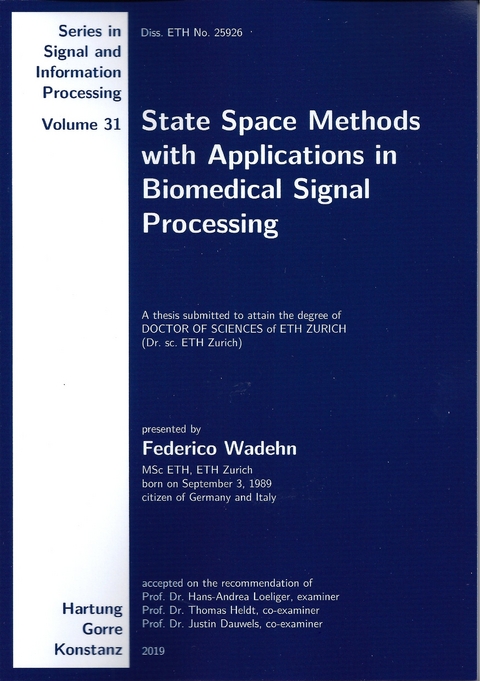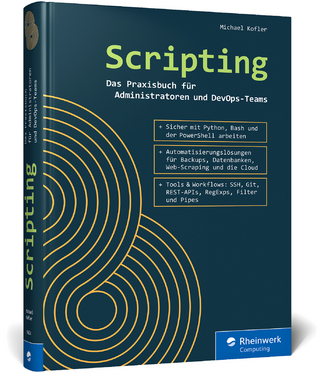
State Space Methods with Applications in Biomedical Signal Processing
Seiten
2019
|
2019
Hartung-Gorre (Verlag)
978-3-86628-640-5 (ISBN)
Hartung-Gorre (Verlag)
978-3-86628-640-5 (ISBN)
- Keine Verlagsinformationen verfügbar
- Artikel merken
For more than a decade, the model-based approach to signal processing based on state space models (SSMs) and factor graphs is being pursued at the Signal and Information Processing Laboratory of ETH Zurich and other groups around the world. This thesis contributes to the theory and methods of this approach, and showcases some biomedical applications; thereby, further highlighting its usefulness. The proposed models and estimation algorithms, however, are applicable beyond the field of biomedical signal processing.
In Part 1 of this thesis we cover modeling, inference, and learning with SSMs and factor graphs. First, we introduce the topic of probabilistic modeling of signals and systems with SSMs and factor graphs. Then, we discuss how to perform inference in linear Gaussian models by Gaussian message passing. When applied to linear SSMs, Gaussian message passing generalizes Kalman filtering and can be used for diverse tasks such as input- and state estimation as well as output smoothing. Using this message passing perspective, two matrix-inversion-free Kalman smoothers are derived (the MBF and BIFM smoothers) and subsequently extended to their respective square root versions. Square root Gaussian message passing is particularly suitable for applications where numerical stability issues arise. After having described inference algorithms, we cover learning algorithms for linear models and SSMs, with a particular focus on learning with sparsity. For this, we rely on variational representations of sparsity-promoting priors called normals with unknown variances (NUV). The NUV representation suggests estimation algorithms based on alternating maximization and expectation maximization (EM). The latter approach commonly requires a round of Gaussian message passing at each EM iteration. Combining SSMs with sparsity opens up many applications, from outlier-robust estimation, to event detection, to signal separation. To handle signals whose variances or sparsity patterns have temporal correlations, a model denoted by state space models with dynamical and sparse variances is proposed. For this model we present approximate inference algorithms based on EM- and variational message passing. The theoretical part of this thesis concludes with a duality perspective on inference and learning in factor graphs. Dual factor graphs represent a dual optimization problem or equivalently a dual estimation problem and are based on the Legendre transformation on factor graphs and the Fenchel duality theorem. Dualizing factor graphs of SSMs results in dual SSMs. These can be used to show that the MBF and BIFM smoothers are dual algorithms. We then proceed to deriving the so called Hamiltonian system using dual SSMs. The Hamiltonian system can be seen as a transformed form of the Karush–Kuhn–Tucker (KKT) conditions of optimality for state estimation in SSMs. The Hamiltonian equations can be solved by iterative algorithms. Algorithms that iteratively solve the Hamiltonian system are alternatives to Kalman smoothing and are a promising approach for estimation in large-scale SSMs, because these primal-dual algorithms do not require the storage of covariance matrices. Finally, the variational NUV representation of sparsity-promoting priors is derived via the Legendre transform on factor graphs. Subsequently, we show how to use Hamiltonian iterations and NUVs for outlier-robust estimation in SSMs.
In Part 2, various state space methods are used for analyzing physiological signals and systems. In particular, two cardiovascular signal processing applications are presented. One is an approach for robustly detecting heart beats in photoplethysmogram recordings using autonomous state space models and localized model fitting. In the other, we use Gaussian message passing for input estimation in SSMs to detect heart beats in ballistocardiogram recordings. Finally, we use sparse input estimation in SSMs for estimating neural controller signals and for performing a model-based separation of the different types of eye movements (saccades, smooth pursuit, and fixations) present in free-viewing eye movement recordings.
In Part 1 of this thesis we cover modeling, inference, and learning with SSMs and factor graphs. First, we introduce the topic of probabilistic modeling of signals and systems with SSMs and factor graphs. Then, we discuss how to perform inference in linear Gaussian models by Gaussian message passing. When applied to linear SSMs, Gaussian message passing generalizes Kalman filtering and can be used for diverse tasks such as input- and state estimation as well as output smoothing. Using this message passing perspective, two matrix-inversion-free Kalman smoothers are derived (the MBF and BIFM smoothers) and subsequently extended to their respective square root versions. Square root Gaussian message passing is particularly suitable for applications where numerical stability issues arise. After having described inference algorithms, we cover learning algorithms for linear models and SSMs, with a particular focus on learning with sparsity. For this, we rely on variational representations of sparsity-promoting priors called normals with unknown variances (NUV). The NUV representation suggests estimation algorithms based on alternating maximization and expectation maximization (EM). The latter approach commonly requires a round of Gaussian message passing at each EM iteration. Combining SSMs with sparsity opens up many applications, from outlier-robust estimation, to event detection, to signal separation. To handle signals whose variances or sparsity patterns have temporal correlations, a model denoted by state space models with dynamical and sparse variances is proposed. For this model we present approximate inference algorithms based on EM- and variational message passing. The theoretical part of this thesis concludes with a duality perspective on inference and learning in factor graphs. Dual factor graphs represent a dual optimization problem or equivalently a dual estimation problem and are based on the Legendre transformation on factor graphs and the Fenchel duality theorem. Dualizing factor graphs of SSMs results in dual SSMs. These can be used to show that the MBF and BIFM smoothers are dual algorithms. We then proceed to deriving the so called Hamiltonian system using dual SSMs. The Hamiltonian system can be seen as a transformed form of the Karush–Kuhn–Tucker (KKT) conditions of optimality for state estimation in SSMs. The Hamiltonian equations can be solved by iterative algorithms. Algorithms that iteratively solve the Hamiltonian system are alternatives to Kalman smoothing and are a promising approach for estimation in large-scale SSMs, because these primal-dual algorithms do not require the storage of covariance matrices. Finally, the variational NUV representation of sparsity-promoting priors is derived via the Legendre transform on factor graphs. Subsequently, we show how to use Hamiltonian iterations and NUVs for outlier-robust estimation in SSMs.
In Part 2, various state space methods are used for analyzing physiological signals and systems. In particular, two cardiovascular signal processing applications are presented. One is an approach for robustly detecting heart beats in photoplethysmogram recordings using autonomous state space models and localized model fitting. In the other, we use Gaussian message passing for input estimation in SSMs to detect heart beats in ballistocardiogram recordings. Finally, we use sparse input estimation in SSMs for estimating neural controller signals and for performing a model-based separation of the different types of eye movements (saccades, smooth pursuit, and fixations) present in free-viewing eye movement recordings.
| Erscheinungsdatum | 31.05.2019 |
|---|---|
| Reihe/Serie | Series in Signal and Information Processing ; 31 |
| Zusatzinfo | zahlr. auch farbige Abb. |
| Verlagsort | Konstanz |
| Sprache | englisch |
| Maße | 148 x 210 mm |
| Gewicht | 320 g |
| Themenwelt | Mathematik / Informatik ► Informatik ► Netzwerke |
| Medizin / Pharmazie ► Medizinische Fachgebiete ► Intensivmedizin | |
| Schlagworte | Biomedical Signal Processing • cardiovascular signals • duality factor graphs • eye movements • physiological models • state space models • Statistical Signal Processing • system identification |
| ISBN-10 | 3-86628-640-6 / 3866286406 |
| ISBN-13 | 978-3-86628-640-5 / 9783866286405 |
| Zustand | Neuware |
| Haben Sie eine Frage zum Produkt? |
Mehr entdecken
aus dem Bereich
aus dem Bereich
das umfassende Handbuch für den Einstieg in die Netzwerktechnik
Buch | Hardcover (2023)
Rheinwerk (Verlag)
29,90 €
das Praxisbuch für Admins und DevOps-Teams
Buch | Hardcover (2023)
Rheinwerk (Verlag)
39,90 €


